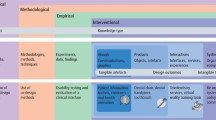Abstract
Using the electric toothbrush as an example, this article examines the growing acceptability of domestic health technologies that blur the traditional boundaries between health, aesthetics and consumption. By using empirical material from individual and household interviews about people’s oral health practices, this research explores the relationships between an everyday artefact, its users and their environments. It investigates the ways in which oral health technologies do, or do not, become domesticated in the home environment. We conclude that the domestication of oral health technologies is not inevitable, with the electric toothbrush often becoming an ‘unstable object’ in the domestic setting.
Similar content being viewed by others
Notes
This study received ethical approval from the London School of Hygiene and Tropical Medicine’s ethics committee before the fieldwork commenced.
References
Akrich, M. and Latour, B. (1992) A summary of a convenient vocabulary for the semiotics of human and nonhuman assemblies. In: W.E. Bijker and J. Law (eds.) Shaping Technology/Building Society. Cambridge, MA: MIT Press.
Aune, M. (1996) The computer in everyday life: Patterns of domestication of a new technology. In: M. Lie and K.H. Sørensen (eds.) Making Technology Our Own? Domesticating Technologies into Everyday Life. Oslo, Norway: SUP.
Bunton, R. and Burrows, R. (1995) Consumption and health in the ‘epidemiological’ clinic of late modern medicine. In: R. Bunton, S. Netttleton and R. Burrows (eds.) The Sociology of Health Promotion. London: Routledge.
Callon, M. (1987) Society in the making: The study of technology as a tool for sociological analysis. In: W.E. Bijker, T.P. Hughes and T.J. Pinch (eds.) The Social Construction of Technical Systems: New Directions in the Sociology and History of Technology. Cambridge, MA and London: MIT Press.
Douglas, M. (1966) Purity and Danger. London: Routledge Kegan Paul.
Exley, C. (2009) Bridging a gap: the (lack of a) sociology of oral health and healthcare. Sociology of Health & Illness 31 (7): 1093–1108.
Fairclough, N. (1995) Critical Discourse Analysis. London: Longman.
Fox, N., Ward, K. and O’Rourke, A.J. (2005) The ‘expert patient’: Empowerment or medical dominance? The case of weight loss, pharmaceutical drugs and the internet. Social Science & Medicine 60 (6): 1299–1309.
Fox, N. and Ward, K. (2006) Health identities: From expert patient to resisting consumer. Health: An Interdisciplinary Journal for the Social Study of Health, Illness and Medicine 10 (4): 461–479.
Green, J. and Hart, L. (1999) The impact of context on data. In: R. Barbour and J. Kitzinger (eds.) Developing Focus Group Research: Politics, Theory and Practice. London: Sage.
Jardim, J., Alves, L. and Maltz, M. (2009) The history and global market of oral home-care products. Brazilian Oral Research 23 (Special Issue 1): 17–22.
Kitzinger, J. (1994) The methodology of focus groups: The importance of interaction between research participants. Sociology of Health & Illness 16 (1): 103–121.
Latour, B. (1992) Where are the missing masses? Sociology of a few mundane artefacts. In: W. Bijker and J. Law (eds.) Shaping Technology/Building Society. Cambridge, MA: MIT Press.
Latour, B. (1999) Pandora’s Hope: Essays on the Reality of Science Studies. Cambridge, MA: Harvard University Press.
Lie, M. and Sørensen, K.H. (eds.) (1996) Making technology our own? Domesticating technologies into everyday life. In: Making Technology Our Own? Domesticating Technologies into Everyday Life. Oslo, Norway: SUP.
McGrath, K. and Travers, B. (1998) World of Invention. Washington DC: Gale Research.
Michael, M. (2000) Reconnecting Culture, Technology and Nature: From Society to Heterogeneity. London: Routledge.
Michael, M. (1997) Inoculating gadgets against ridicule. Science as Culture 6 (2): 167–194.
Mielczarek, M. et al (2012) A novel power toothbrush with multi-directional, triple zone cleaning technology. American Journal of Dentistry 25 (Special Issue A): 4A–9A.
Nettleton, S. (1988) Protecting a vulnerable margin: Towards an analysis of how the mouth came to be separated from the body. Sociology of Health & Illness 10 (2): 156–169.
Nettleton, S. (1991) Wisdom, diligence, and teeth: Discursive practices and the creation of mothers. Sociology of Health & Illness 13: 98–111.
Nettleton, S. (1992) Power, Pain and Dentistry. Buckingham, UK: Open University Press.
Oudshoorn, N. and Pinch, T. (eds.) (2003) How Users Matter: The Co-Construction of Users and Technologies. Cambridge, MA: MIT Press.
Perri, Jupp, B. and Bentley, T. (1996) Open Wide: Futures for Dentistry in 2010. London: Demos.
Potter, J. and Wetherell, M. (1987) Discourse and Social Psychology. London: Sage.
Prout, A. (1996) Actor network theory, technology and medical sociology: An illustrative analysis of the metered dose inhaler. Sociology of Health & Illness 18 (2): 198–219.
Rip, A. (2003) Constructing expertise: In a third wave of science studies? Social Studies of Science 33 (3): 419–434.
Shove, E. and Southerton, D. (2000) Defrosting the freezer: From novelty to convenience. Journal of Material Culture 5 (3): 301–319.
Silverstone, R., Hirsh, E. and Morley, D. (1992) Information and communication technologies and the moral economy of the household. In: R. Silverstone and E. Hirsh (eds.) Consuming Technologies: Media and Information in Domestic Spaces. London: Routledge.
Starr Sered, S. and Fernandopulle, R. (2005) Uninsured in America: Life and Death in the Land of Opportunity. Berkeley, CA: University of California Press.
Thorogood, N. (2000) Mouthrules and the construction of sexual identities. Sexualities 3 (2): 165–182.
Warde, A. (2005) Consumption and theories of practice. Journal of Consumer Culture 5 (2): 131.
Whelton, H. (2004) Overview of the impact of changing global patterns of dental caries experience on caries clinical trials. Journal of Dental Research 83 (S1): C29–C34.
Wong, V. (2012) SmithKline Beecham Healthcare (SBCH): Dr Best Flex toothbrush. In: P. Doyle and S. Bridgewater (eds.) Innovations in Marketing. London: Routledge.
Author information
Authors and Affiliations
Corresponding author
Rights and permissions
About this article
Cite this article
Carter, S., Green, J. & Thorogood, N. The domestication of an everyday health technology: A case study of electric toothbrushes. Soc Theory Health 11, 344–367 (2013). https://doi.org/10.1057/sth.2013.15
Published:
Issue Date:
DOI: https://doi.org/10.1057/sth.2013.15




